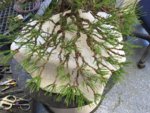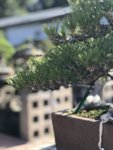Zach Smith
Omono
Only wire what needs to be wired. I have never noticed that the trees cared. I do work almost exclusively with deciduous species, so maybe the pines and junipers are touchy.
Yes, but the question here is: do I have to wire the whole tree even if I am in need to bend just a couple of branches?
Hah, it is coincident because I just posted something like these this morning. Please look at post # 132 https://www.bonsainut.com/threads/korean-black-pine-in-training.22212/page-7#post-582338Well, I think the reasoning goes to the fact that after wiring and bending, a lot of fissures will be on the wired branches.
And they must heal somehow.
My Idol in philosophy.Vance, you are morphing into Yogi Berra!
There are those who will tell you that leaving wire on a tree over winter will cause the death of the branch/tree. This seems to have validity with JBP's.Here's my experience-- Japanese white pine. An old import grafted on JBP. I wired 10 or 11 of the lowest branches to move them lower; let in some light. The tree began to abandon those lower branches in early spring and currently all of the wired branches are dead. Rest of the tree is fine. Never again.
I didn't mean to imply that season was an issue other than there are those that claim keeping wire on a couple of species of trees over the winter can cause damage?I have seen wiring damage branches. If the process of wiring (or bending after wiring) separates the cambium from the heartwood, the branch could die.
That’s why the best time to wire is in the fall. As the tree is shutting down for the winter, it “tightens up” the bond between the new softwood and the old heartwood.
With JWP, the best time is in late August until about Thanksgiving. They’re single flush, so they finish growing out before the JBP do. Wiring at other times of the year is riskier, it’s easier to accidentally damage the tree. Especially, if you “twist” the branches.
Since we’re discussing this, Junipers are best wired in the fall. Not in the summer.
JBP can be wired “anytime”, but are best wired in fall or just after decandling. They are perhaps the most tolerant.
JRP are very brittle and easy to snap. They should be done in fall, but bear in mind they snap easily. Anytime.
Ponderosa are very flexible and can be wired anytime. They don’t put n Wood very quickly, so wire doesn’t cut in. They also take several years to “set”. Same with Atlas Cedar.
I left wire on my mugo and Scots over last winter.I didn't mean to imply that season was an issue other than there are those that claim keeping wire on a couple of species of trees over the winter can cause damage?
Actually, you shouldn’t wire pines leaving the tips op. The should be pretty much straight out. Maybe a little bit up. But mostly out.Good points, but you didn't mention keeping yourtitstips up with pines, @Adair M. It should be easy for all of us to remember.



I’ve never had that problem with JBP, Vance, but then again, I don’t live in the North.I didn't mean to imply that season was an issue other than there are those that claim keeping wire on a couple of species of trees over the winter can cause damage?
Not because you might damage them, it’s becsuse the new growth will grow up. If you turn the tips up, when the new shoots come in, they will make the pads too tall. Because they will be starting at a higher position.Let me try to paraphrase back to you what I hear you saying - correct me, if ...
Don't try to wire the tips/buds up because you might damage them. Just make sure they aren't pointing down. They will, over the following months, turn themselves up.
Let us include JWP in this.



It's not just for the sake of doing it; the reason is to "hurt" the whole tree, not only some branches, as this nursery owner suggests.I can't see any logic wiring branches for the sake of it.
My opinion completely here but I'm calling bullshit on that one. By that logic if you cut a branch back on one it should be done to all... LolIt's not just for the sake of doing it; the reason is to "hurt" the whole tree, not only some branches, as this nursery owner suggests.
I am used to wire only the branches that need wiring, so I asked here.
The nursery owner is incorrect. If his experience says if he doesn’t wire the whole tree because the wired branch will die if he doesn’t, he’s doing something wrong!It's not just for the sake of doing it; the reason is to "hurt" the whole tree, not only some branches, as this nursery owner suggests.
I am used to wire only the branches that need wiring, so I asked here.
Thanks guys, I agree it makes no sense.The nursery owner is incorrect. If his experience says if he doesn’t wire the whole tree because the wired branch will die if he doesn’t, he’s doing something wrong!
